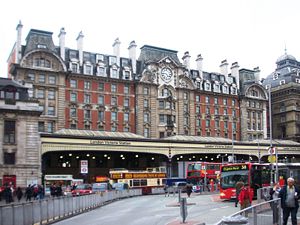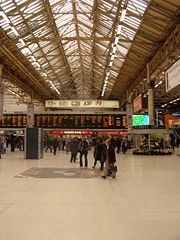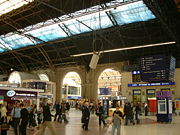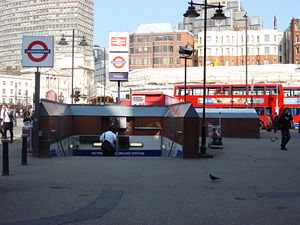London Victoria station
 The Grosvenor Hotel which is the frontage of the Brighton Main Line platforms |
|
| Location | Belgravia |
|---|---|
| Local authority | City of Westminster |
| Managed by | Network Rail |
| Station code | VIC |
| Platforms in use | 19 |
| Travelcard zone | 1 |
| NR 2004/5 usage | 48.047 million[1] |
| NR 2005/6 usage | 47.860 million[1] |
| NR 2006/7 usage | 66.749 million[1] |
|
|
|
| 1862 | Opened |
|
|
|
| List of stations | Underground • National Rail |
| External links | Departures • Facilities |
|
|
|
London Victoria is a major London Underground, National Rail and Coach station in the City of Westminster. It is the second busiest railway terminus in London after Waterloo. It is in Travelcard Zone 1.
Contents |
National Rail
The National Rail station is officially named London Victoria[2], a name that is commonly used outside London, but rarely by Londoners. Operationally, there are effectively two separate stations:
- The eastern (Chatham) side, comprising platforms 1–8, is the terminus for services to Kent on the Chatham Main Line and its branches.
- The western (Brighton) side, comprising platforms 9–19, is the terminus for services to Surrey and Sussex, including Gatwick Airport and Brighton on the Brighton Main Line and its branches.
This split is generally held to, as the track layout does not allow much swapping, with only a small number of connecting flyovers between the main lines in the Battersea area, plus a single track connection immediately outside the station. As the Brighton side is the busier of the two, disruption on that line sometimes results in some of its suburban services using the eastern side. This is particularly true of the Gatwick Express, which travels along the Brighton Main Line, as it will often divert over Chatham side tracks during engineering works in order to maintain service levels.
Victoria also serves as the London terminus for the Venice Simplon Orient Express, from Platform 2, the longest platform.
Early history

Its origins lie with the Great Exhibition of 1851. The West End of London and Crystal Palace Railway was incorporated on 4 August 1853 to serve the new site of the exhibition, which had been transferred to Sydenham from Hyde Park. There were plans for a large terminal, but at first a temporary station was constructed in Battersea, at the southern end of the new Chelsea Bridge. The station, despite its location called the Pimlico Terminal, opened on 27 March 1858.
However, it was soon recognised that a terminal was needed on the north side of the River Thames, and on 23 July 1858 the Victoria Station & Pimlico Railway was incorporated, with the object of extending the railway across the river to a more convenient location nearer the West End. The railway was owned by four railway companies: the Great Western (GWR); London & North Western (LNWR); the London, Brighton and South Coast (LBSCR); and the London, Chatham and Dover Railways (LCDR).
The station opened on 1 October 1860 (the temporary terminus in Battersea having closed the day before).[3] It was formed in two parts: the western side, occupied by the Brighton company, with six platforms, ten tracks and a hotel (the 300-bedroom Grosvenor); while the Chatham company occupied a less imposing wooden-fronted building. The latter's station had nine tracks and was shared by broad-gauge trains of the GWR, which arrived from Southall via the West London Extension Joint Railway through Chelsea. The approach tracks and station were built on the route and basin of the Grosvenor Canal.
The GWR remained part owner of the station until 1932, although its trains had long since ceased to use it. Each side of the station had its own entrance and a separate station master; a wall between the two sections emphasised that fact.
A plaque marks the arrival of the body of The Unknown Warrior at platform 8 at 20:32 on 10 November 1920.
Rebuilding

At the start of the 20th century both parts of the station were rebuilt. It now had a decent frontage and forecourt, but not as yet a unified existence. Work on the Brighton side was completed in 1908 and was carried out in red brick; the Grosvenor Hotel was rebuilt at the same time. The Chatham side, in an Edwardian style with baroque elements, designed by Alfred Bloomfield, was completed a year later. The two sections were connected in 1924 by removing part of a screen wall, when the platforms were renumbered as an entity.
The station was now serving boat trains, and during World War I it became a terminus for trains carrying soldiers to and from France, many of them wounded. After the war the Continental steamer traffic became concentrated here, including the most famous of those trains, the Golden Arrow. The Night Ferry also operated to/from Victoria station. The area around the station also became a site for other forms of transport: a bus station in the forecourt; a coach terminal to the south; and now a terminal for trains serving Gatwick Airport.
The station had a news cinema later a cartoon cinema that would show a continuous programme for travellers. The cinema was designed by Alastair Macdonald, son of Prime Minister Ramsay MacDonald and was in operation from 1933 until being demolished in 1981.
The station was redeveloped internally in the 1980s, with the addition of shops within the concourse, and above the western platforms (the "Victoria Place" shopping centre).
On 18 February 1991 an IRA bomb exploded in a litter bin, killing David Corner [4], and injuring 38.
| Preceding station | National Rail | Following station | ||
|---|---|---|---|---|
| Terminus | Southeastern Catford Loop Line |
Denmark Hill | ||
| Southeastern Chatham Main Line (via Herne Hill) |
Brixton | |||
| Terminus | Southern Brighton Main Line |
Battersea Park or Clapham Junction |
||
| Terminus | Southern Gatwick Express |
Gatwick Airport | ||
| Terminus | Venice Simplon Orient Express London-Paris-Venice |
Folkestone Harbour | ||
Trivia
- It is mentioned in the Monty Python's Flying Circus sketch "Blackmail" in the "Live from the Grill-O-Mat" episode.
- In Oscar Wilde's The Importance of Being Earnest, the title character was found as an infant in a handbag at Victoria Station, much to the consternation of Lady Bracknell. "A handbag?" "The Brighton line" "The line is immaterial!"
London Underground
 |
|
| Location | Belgravia |
|---|---|
| Local authority | City of Westminster |
| Managed by | London Underground |
| Platforms in use | 4 |
| Travelcard zone | 1 |
| LUL 2005 usage | 67.823 million[5] |
| LUL 2007 usage | 76.406 million[5] |
|
|
|
| 1868 1872 1872 1900 1908 1949 1968 1971 |
Opened (MDR) Started "Outer Circle" (NLR) Started "Middle Circle" (H&CR/MDR) Ended "Middle Circle" Ended "Outer Circle" Started (Circle Line) Opened as terminus (Victoria Line) Extended south (Victoria Line) |
|
|
|
| List of stations | Underground • National Rail |
The London Underground station lies to the north of the mainline station concourse.It is currently the busiest station on the system with around 76 million using the station as of 2007. There are two ticket halls: the newer hall, closer to the mainline station serves the Victoria Line; the other, further north serves the District and Circle Lines. The ticket halls are connected by a pedestrian passage beneath the Bus station.
History
The first part of the station was opened on 24 December 1868 by the Metropolitan District Railway (MDR, now the District Line) when the company opened the first section of its line between South Kensington and Westminster stations. The MDR connected to the Metropolitan Railway (MR, later the Metropolitan Line) at South Kensington and, although the two companies were rivals, each company operated its trains over the other's tracks in a joint service known as the "Inner Circle".
On 1 February 1872, the MDR opened a northbound branch from its station at Earl's Court to connect to the West London Extension Joint Railway (WLEJR, now the West London Line) which it connected to at Addison Road (now Kensington (Olympia)). From that date the "Outer Circle" service began running over the MDR's tracks. The service was run by the North London Railway (NLR) from its terminus at Broad Street (now demolished) in the City of London via the North London Line to Willesden Junction, then the West London Line to Addison Road and the MDR to Mansion House - the new eastern terminus of the MDR.
From 1 August 1872, the "Middle Circle" service also began operations through Victoria running from Moorgate along the MR's tracks on the north side of the Inner Circle to Paddington then over the Hammersmith & City Railway (H&CR) track to Latimer Road then, via a now demolished link, to the West London Line to Addison Road and the MDR to Mansion House. The service was operated jointly by the H&CR and the MDR.
On 30 June 1900, the Middle Circle service was withdrawn between Earl's Court and Mansion House. On 31 December 1908 the Outer Circle service was also withdrawn.
The original MDR station was rebuilt at the beginning of the 20th century initially as a single storey structure. An office building was constructed above it later.
In 1949, the Metropolitan Line operated Inner Circle route was given its own identity on the tube map as the Circle Line.
The new Victoria Line station was opened on 7 March 1969 when the third phase of the line began operating south of Warren Street. Initially, Victoria served as the temporary terminus of the line whilst the final phase was under construction to Brixton. Services to Brixton began operating on 23 July 1971.
Future
Victoria is a proposed stop on the Chelsea-Hackney Line also known as Crossrail 2. [6] [7] [8] The route was safeguarded in 1991[9] and 2007 and any rebuilding of the station will have space for Crossrail 2 platforms.[10] In the safegaurded route it was between Chelsea and Piccadilly Circus.
| Preceding station | Following station | |||
|---|---|---|---|---|
|
Sloane Square
towards High Street Kensington
|
Circle line |
St. James's Park
towards Aldgate
|
||
|
Sloane Square
towards Wimbledon, Richmond
or Ealing Broadway |
District line |
St. James's Park
towards Upminster
|
||
|
Pimlico
towards Brixton
|
Victoria line |
Green Park
towards Walthamstow Central
|
Current situation
The station is now the busiest on the London Underground system, serving nearly 80 million passengers per year. The station was not built for this number of passengers, which results in severe overcrowding. To prevent any dangerous situations like crowds pushing people off the platforms onto the track, crowd control measures are in place at the busiest times. This effectively means closing all the entrances to the Underground platforms and operating as an exit-only station until the overcrowding is relieved. These measures can last anywhere between a couple of minutes (when minor delays are occurring) up to several hours (during major incidents).
In order to provide a lasting solution to this problem, a major upgrade[11] of the station is planned, including a new exit/entrance to both Victoria and Circle/District Line platforms at Bressenden Place. This upgrade is due by 2014[12].
Gallery
Trivia
An abandoned Victoria Underground station features in the V for Vendetta comic book series as the base for the anarchist freedom fighter "V".
Coach station
Victoria coach station is half a mile south-west of the railway stations. It is the main London coach terminal and serves all parts of the UK, and mainland Europe.
References
- ↑ 1.0 1.1 1.2 Annual passenger usage based on sales of tickets in stated financial year(s) which end or originate at London Victoria station from Office of Rail Regulation statistics
- ↑ Association of Train Operating Companies (2005). National Rail Enquiries - Station Facilities for London Victoria. Retrieved December 24 2005.
- ↑ "Railway Magazine", March 1958
- ↑ An Index of Deaths from the Conflict in Ireland 1969-1993 (1994) Malcolm Sutton ISBN 0-9514229-4-4 [1]. Retrieved January 12 2007.
- ↑ 5.0 5.1 Transport for London - London Underground performance update
- ↑ alwaystouchout.com - Crossrail 2
- ↑ T2025 Transport vision for a growing world city - 28 November stakeholder event slides
- ↑ http://www.crossrail.co.uk/80256B090053AF4C/Files/chelsea-hackneyline/$FILE/chelsea+hackney+line+safeguarding+leaflet+february+2008.pdf
- ↑ http://www.dft.gov.uk/consultations/closed/consulchelhackney/pdfproposedChelHackroute2
- ↑ London Connections: Look ma, Crossrail 2
- ↑ Transport for London. Victoria tube station
- ↑ Transport for London. Victoria tube station: Next steps
External links
- London Transport Museum Photographic Archive
- Mainline station
- Underground station
- Station information on Victoria Station from Network Rail
|
|||||||||||
|
||||||||||||||||||||||||||||||||||||

